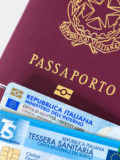Glossary Digital Identity Verification
Digital Identity Verification
Digital identity verification for businesses
An increasing number of business processes are taking place digitally, ranging from signing contracts and opening accounts to age verification. Digital identity verification is crucial for building trust and protecting sensitive data. It helps companies to prevent identity fraud, automate processes, and ensure compliance with regulations.
In this article, we explain what digital identity verification is, which methods have proven successful and how companies can benefit from automated online solutions, particularly when it comes to digitally onboarding new customers.
What does digital identity verification mean?
Digital identity verification is the process of confirming someone's identity online. This involves using modern technologies such as biometrics, document verification and electronic identification (eID). The aim is to confirm a person's identity without them having to appear in person.
Digital identities consist of a combination of personal data and digital characteristics that are verified during the identification process. For companies, this means enhanced security, scalability, and an optimised customer experience.
Benefits for businesses
1. Building trust & avoiding fraud:
Digital identity verification protects both customers and businesses from identity theft, account takeover and money laundering. Methods such as facial recognition and liveness detection can be used to verify that the user is who they claim to be and does not have a stolen identity.
2. Optimise conversion & avoid abandonment:
Outdated identification procedures act as a deterrent. Long waiting times and media discontinuity increase the abandonment rate. A digital identity check that is free from media discontinuity can streamline processes and improve customer experience. This enables you to sustainably enhance the quality of your conversions during the onboarding process.
3. Scalable and cost-effective:
Digital identity verification replaces manual processes with scalable automation. This enables you to reduce personnel costs, speed up processes and handle high user numbers without additional back-office effort.
Why digital identity verification is essential today
Face-to-face meetings involving ID checks and handshakes at local offices are becoming increasingly rare. In the digital world, new ways of building trust are needed that do not compromise on security or user-friendliness. Online identity verification makes this possible. It is legally compliant, efficient, and can be used worldwide.
A look at the figures shows that an increasing number of people are using digital identity functions. According to the 2024 eGovernment MONITOR, 22% of Germans have already used the online ID function (eID), and this figure is increasing.
Risks and challenges of online identity verification
In an increasingly digital world, the risk of identity theft is also growing. Cybercriminals use stolen or leaked data to impersonate others online for purposes such as financial fraud or account abuse. Past major data leaks on platforms such as LinkedIn and eBay have demonstrated how quickly millions of digital identities can fall into the wrong hands.
Access to personal information such as a person's name, date of birth or ID number is often enough to take over their account, which can have serious consequences for them and their providers.
Therefore, anyone offering digital services must reliably verify the identity of their users. This is the only way to effectively prevent identity theft, money laundering, and the misuse of customer accounts. Modern identity verification solutions address this issue by combining security with user-friendliness.
Three established methods of digital identity verification
Not all digital identity verification is the same. Depending on factors such as the industry, legal situation and security requirements, companies have various technologies at their disposal with which to securely and efficiently verify users. Three methods have proven particularly effective, each with its own strengths. These methods are particularly powerful when used in combination:
Document verification
This is the classic form of identity verification: users photograph their ID card or passport, after which the software automatically checks that the document is genuine and that the personal data matches. This enables digital documents to be verified.
It is important to look for an identity verification solution that can reliably recognise security features such as holograms, fonts and layouts, and that supports globally relevant document types.
Another option is eID (electronic identity card), where users verify themselves by placing their ID card on an NFC-enabled device.
Biometric facial verification
Modern algorithms use Selfie identification to compare a person with their ID photo in real time. This verifies that the person in the photograph is the same person standing in front of the camera.
Advantages:
- No human verification necessary
- Lightning-fast online identity verification
- User-friendly on mobile devices
Challenges:
- Facial expressions, glasses, beards or poor lighting conditions can make recognition difficult.
- It is therefore important to have an AI-based solution that works reliably even under real-world conditions.
Liveness Detection
Reliable live detection protects against deepfakes, face masks and photo editing. It can tell whether there is a real person sitting in front of the camera.
Aktiv vs. Passiv:
- Active methods involve asking the user to blink or nod.
- In contrast, modern passive systems automatically analyse micro-movements without requiring any input from the user. This improves the user experience and reduces the abandonment rate.
Digital identity verification as a competitive advantage
If you are a bank, insurance company, e-commerce business or platform operator, using modern digital identity verification will mean benefiting from automated processes, greater security and increased trust. At the same time, your costs will be reduced and your customers' experience will be enhanced.
PXL Vision offers a powerful, AI-supported digital customer onboarding solution. It is scalable, flexible and fully automatable. Contact us now.
FAQ on digital identity verification
Digital identity verification is a process that verifies the authenticity of a person's identity online. It involves the use of biometric methods, document verification and facial verification.
Mostly through a combination of document verification and biometric facial verification. The ID card is scanned and the face is compared with the ID photo.
Highly reputable – modern technologies ensure the highest security standards. Biometrics, eID and liveness detection provide reliable protection against identity theft and fraud.
Local verification is based on national requirements, while global solutions take into account various international data sources and legal requirements.
Whenever international transactions take place – e.g. in finance, e-commerce or cross-border property purchases. It is also essential for combating money laundering.
.png?width=126&height=101&name=logo%20(2).png)
.png?width=63&height=51&name=logo%20(6).png)




